I just updated my Now page.
I just updated my Now page.
I still have a dozen or so books on my Kindle, so for now, my Kobo is where I read essays and longform articles saved to my Instagram account. I’m still working on what device will be my dedicated reader. Like some of you, I’m not a fan of being locked into a platform because that way leads to eventual enshittification. I’m also not thrilled that when I purchase an e-book, I’m actually buying the license that allows me to read it. For the time being, that may be a necessary evil of reading ebooks, but I’d at least like to choose which device I read that book on.
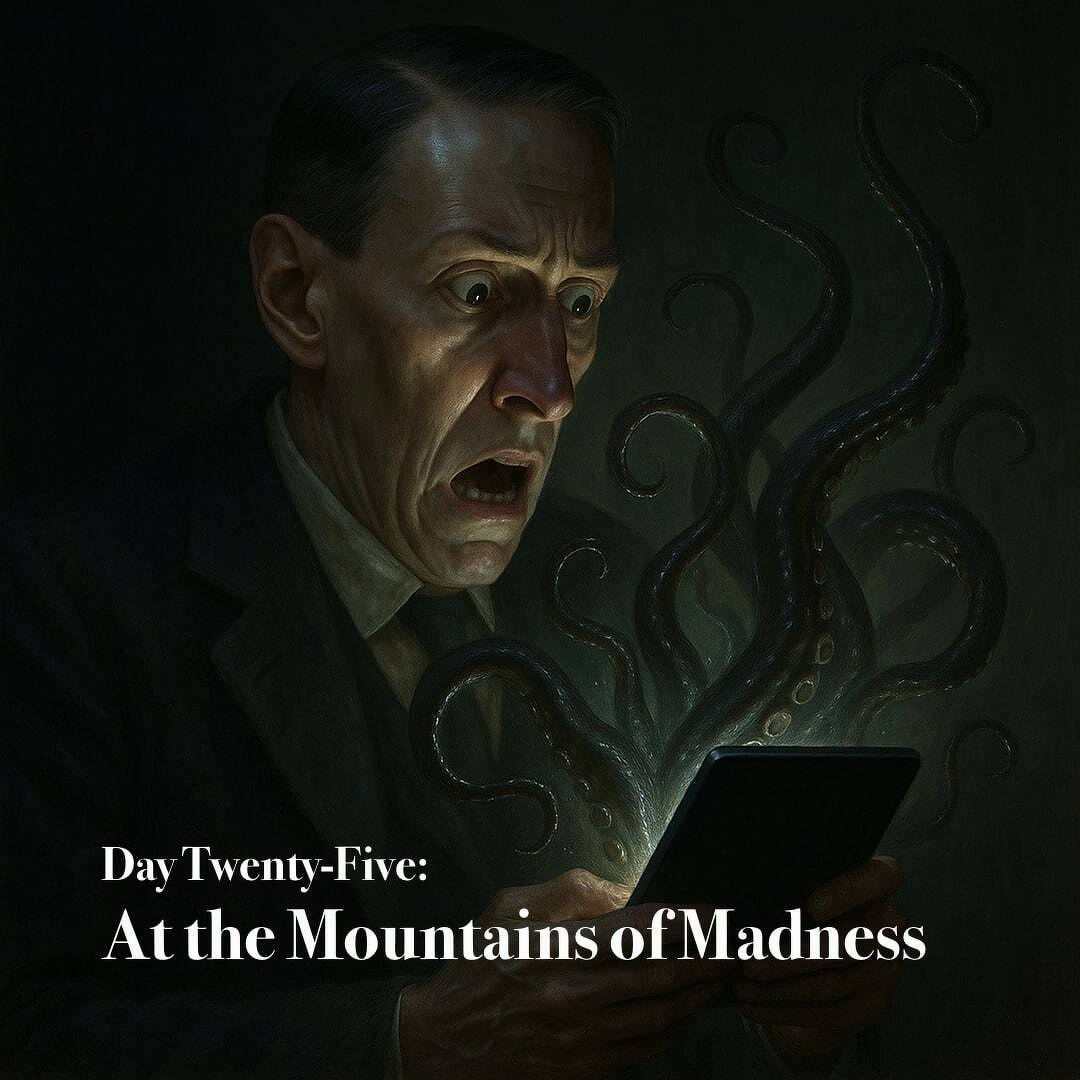
Among the countless works of cosmic dread, few have inspired such awe as H. P. Lovecraft’s At the Mountains of Madness. Even the visionary Guillermo del Toro has long sought to breathe its frozen terrors into living image. Yet I confess that this tale once left my own soul unmoved, its desolate immensities seeming only cold and remote.
It was not until I encountered Barry Lopez’s Arctic Dreams that I began to sense the secret pulse beneath Lovecraft’s ice-bound nightmare. Lopez writes of the polar realms with reverence and melancholy, of their pale immensities and hidden wonders, of how their silence has lured humankind toward both revelation and ruin. Through his meditations I glimpsed what Lovecraft must have felt: the trembling majesty of a world untouched by time, where the very light seems older than memory.
In that boundless whiteness, Lovecraft’s imagination found its truest stage. The Antarctic became to him not merely a continent but a threshold, the last portal between man’s fragile reason and the vast gulfs of cosmic antiquity. There, beneath the cold constellations, he peopled the endless ice with the spawn of elder aeons, for it was in such loneliness that his myth of Cthulhu’s kind could breathe, timeless and undying beneath the shroud of eternal snow.
Told by Professor William Dyer of the accursed Miskatonic University, At the Mountains of Madness stands as a dire confession and warning, a chronicle of things best left buried beneath the world’s white and merciless extremity. His words are not of adventure, but of revelation, revelation so abominable that reason itself recoils. In the uncharted Antarctic wastes, where the winds shriek like the cries of ancient spirits and the sun gleams upon deathless ice, Dyer’s doomed expedition sought knowledge that man was never meant to claim. Beyond a range of mountains taller than the Himalayas there lay the relics of an age before the birth of mankind, and in that frozen desolation slept truths too monstrous for mortal comprehension.
Under Professor Lake, an advance party exhumed fourteen forms from the eternal ice, creatures of neither plant nor beast, yet possessed of both natures. Their star-shaped visages and ridged bodies bespoke aeons unrecorded, and a mind alien to all the Earth. Even the oldest Cambrian fossils bore upon them the marks of deliberate craft, as though some elder intellect had toyed with the shaping of life itself. When silence fell upon Lake’s camp, Dyer and his student Danforth ventured forth and found horror incarnate. Men and dogs lay mangled and strewn across the snow; two were missing, and six mounds of ice covered what once were the specimens. The rest had fled, leaving behind obscene traces of dissection, as though vivisection had been performed by a hand not human.
Ascending beyond the forbidden peaks, Dyer and Danforth looked upon a city that mocked all architecture of man, a nightmare skyline of black stone and impossible angles, born of mathematics unknown to reason. In those ancient halls they deciphered the saga of the Elder Things, who fell from the heavens before the dawn of life. From their formless arts they birthed the shoggoths, slaves of living protoplasm, shapeless yet obedient, until rebellion rose and empire fell. Upon the walls were carved their wars against the Star-Spawn of Cthulhu and the Mi-Go, and mention of a still deeper horror lurking beyond a mightier range, a Thing even they dared not name.
In the city’s cryptic depths, the explorers beheld pallid, eyeless penguins and the corpses of the Elder race, slain by their own creations. There, amid the black tunnels, they met the shoggoth itself, a vast, heaving, faceless slime that shrieked in voices not of this world. In terror they fled, escaping skyward into the cold air, but Danforth, turning once more to gaze upon the mountains, beheld a sight that shattered his reason forever.
Thus Dyer speaks his final plea: that mankind restrain its arrogance and curiosity, and never again disturb the haunted stillness of that polar tomb. For beneath the ancient ice lie powers and memories older than the Earth, brooding in silence, and dreaming still.
In the conception of At the Mountains of Madness, there stirred within Howard Phillips Lovecraft the ancient pulse of an obsession long possessed of his soul. From the dim corridors of his youth he had peered southward, toward that haunted and eternal whiteness men call the Antarctic, imagining within its untraveled immensities the remnants of civilizations predating all terrestrial memory. As the biographer S. T. Joshi has written, even in boyhood Lovecraft composed curious treatises upon those early polar voyagers, and, fired by W. Clark Russell’s The Frozen Pirate, he spun strange tales of icy desolation and frozen doom.
By the 1920s, that continent remained the last unmapped corner of the Earth, vast regions still untouched by human tread. To Lovecraft’s fevered mind these blank spaces on the charts were not voids, but veils, thin partitions concealing truths older than life itself. In them his imagination was free to erect the monstrous geometries of alien empires buried beneath the glacial crust. Though his tale preceded modern science in its acceptance of continental drift, he captured with uncanny precision the geography and mystery that then defined the polar unknown.
The ill-starred Miskatonic University expedition that ventured into those latitudes was shaped in the likeness of Richard E. Byrd’s heroic enterprise of 1928 to 1930, whose reports of fossilized tropic life Lovecraft seized upon as evidence of a deep and awful antiquity. Lin Carter, one of his later interpreters, would write that Lovecraft’s own mortal aversion to cold lent the story its almost physical chill, the oppressive dread of sub-zero air that gnaws through bone and reason alike.
Yet behind the factual scaffold rose the shadow of earlier dreamers. From Edgar Allan Poe’s The Narrative of Arthur Gordon Pym he drew the echoing cry “Tekeli-li” and that ineffable sense of cosmic approach, the terror of an end too vast to name. From Edgar Rice Burroughs’s At the Earth’s Core came the vision of lost races, winged and scientific, who ruled man as chattel and experimented upon his flesh. The subterranean abyss of A. Merritt’s “The People of the Pit,” the grotesque resurrection of ancient life in Katharine Metcalf Roof’s “A Million Years After,” and the cold fates of explorers lost to the void—these too fed his terrible imagination.
Beneath all, perhaps, lay the philosophy of Oswald Spengler, whose Decline of the West Lovecraft absorbed like scripture, seeing in it the destined decay of all civilizations, human or otherwise. He reached also toward M. P. Shiel’s The Purple Cloud and his own early nightmares, “The Nameless City” and The Dream-Quest of Unknown Kadath, wherein art itself serves as the hieroglyph of forgotten epochs. The story’s title he drew from the opium dream of Lord Dunsany, that whisper of “the ivory hills that are named the Mountains of Madness.”
And when at last he wrote, his vision of that deathly plateau was clothed in the spectral hues of Nicholas Roerich’s painted snows and the cathedral immensities of Gustave Doré’s engravings. Thus the Antarctic became, in Lovecraft’s trembling hand, not a place upon the map, but a mirror of the abyss, where the frozen winds of eternity blow across the ruins of creation, and the soul of man quails before the cosmic cold.
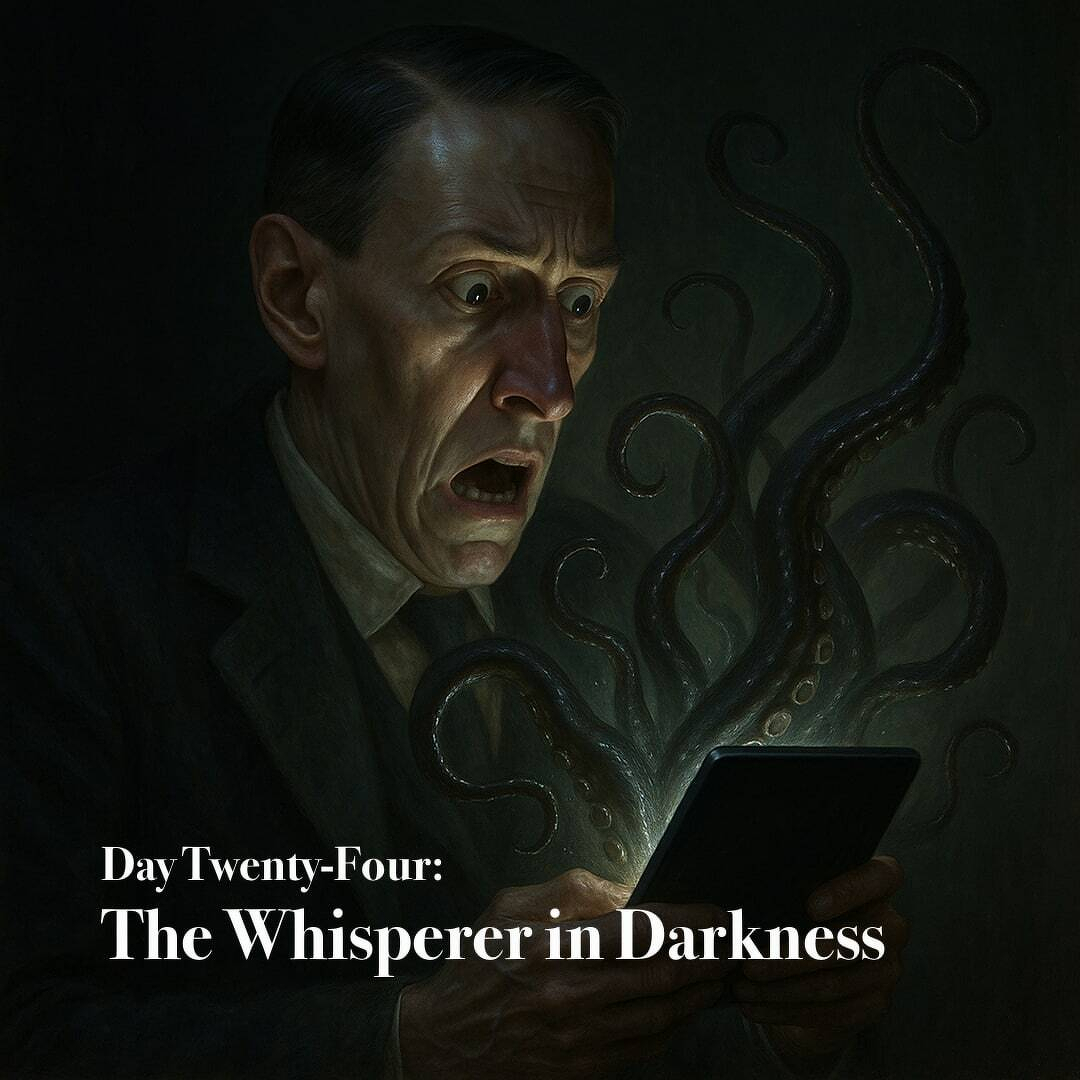
I had just concluded my reading of H. P. Lovecraft’s The Whisperer in Darkness before venturing into the nocturnal chill to attend a screening of Guillermo del Toro’s Frankenstein at the local arthouse theater. Del Toro’s creations never fail to lure me, for in his visions I sense a kinship with the same cosmic dread that haunted the Providence dreamer. Yet I cannot help but yearn for the day when he at last summons his long-desired adaptation of At the Mountains of Madness, that ultimate revelation of mankind’s insignificance beneath the polar wastes. Until that accursed miracle arrives, Hellboy must suffice, with its abominable Cthulhu-like hounds born of unearthly seas and the spectral conjuring of Rasputin amid the Himalayan frost.
And now, as the final echoes of the film dissolve into the night, I return to the tale that began this descent into wonder and horror: The Whisperer in Darkness, whose whisper still threads the wind beyond the stars.
Albert N. Wilmarth, instructor of literature at the ancient and brooding Miskatonic University, found himself drawn into a web of unholy revelations when word spread of uncanny shapes glimpsed amid the swollen rivers of Vermont. At first he mocked such rustic legends, attributing them to the fancies of backwoods minds. Yet the arrival of letters from one Henry Wentworth Akeley, a hermit dwelling in the shadowed hills near Townshend, began to erode his reasoned disbelief. Akeley wrote of voices in the night, of monstrous presences that crept from the forest, and of rituals whispered in the names of Cthulhu and the crawling Nyarlathotep.
Each message grew more dreadful than the last. Akeley spoke of the slaughter of his hounds, of nocturnal gunfire, and of grotesque forms that bled a sickly green fluid unfit for any earthly vein. Then, without warning, the tone altered. The terror gave way to awe. Akeley declared that the beings were not hostile but divine, their knowledge a gateway to the boundless gulfs of infinity. He begged Wilmarth to come at once, promising revelation beyond mortal ken.
When Wilmarth arrived, he found Akeley wasted and still, seated in shadow, his voice a strange, droning murmur that set the nerves on edge. The frail host spoke of cosmic voyages, of minds released from flesh and sealed within metal cylinders to traverse the black gulfs between worlds, bound for Yuggoth, the outer sphere men call Pluto. One of these imprisoned minds spoke to Wilmarth, extolling the glory of such a fate.
That night, haunted by whispers that no human throat could form, Wilmarth crept forth and made a discovery too hideous for sanity. The thing in the chair was gone, leaving only the robe and within it those ghastly remnants that mocked the shape of man. Fleeing in madness, he left the accursed place behind. When daylight came, the farmhouse was found desolate, the traces of battle erased. Only Wilmarth knew the unspeakable truth: that what had worn Akeley’s countenance was not a man at all, and that the true Akeley’s brain had already been borne away into the cold abyss.
In “The Whisperer in Darkness,” there stirs a shadowed homage to Arthur Machen’s The Novel of the Black Seal, for in its haunted pages Lovecraft walks once more the accursed hills where elder beings are said to brood beneath the soil of mankind’s ignorance. Scholar Robert M. Price has discerned in it not mere influence but transformation, a reawakening of Machen’s dreadful vision. As in that earlier chronicle, a seeker of forbidden lore ventures into the lonely uplands, drawn by relics of a prehuman race whose traces yet stain the stones of the Earth.
Lovecraft, ever the dissector of myth, divides Machen’s doomed Professor Gregg into two forms: Wilmarth, the hesitant chronicler of unspeakable truths, and Akeley, the scholar whose faith in reason dissolves before the inhuman reality that calls to him from the hills. Both tales murmur of grotesque shapes glimpsed beside the river’s flow, of those who vanish from the world to serve unseen masters.
Echoes of Robert W. Chambers and Ambrose Bierce drift through Lovecraft’s prose, their spectral dread woven into his tapestry of cosmic horror. Even the tale’s beginning, with its deluge upon the Vermont countryside, rises from earthly record, while the monstrous notion of brains encased in eternal machinery betrays a whisper from J. D. Bernal’s The World, the Flesh, and the Devil, a modern scripture of unholy possibility. Thus the story becomes a convergence of visions, a hymn to the old terrors reborn in the age of reason.

Every October, I find myself listening to bands like Rudimentary Peni (specifically their Cacophony album), Misfits, and Samhain. When I was a young punk, I listened to Samhain more out of obligation, but preferred Misfits to Samhain’s muffled audio. But decades later, I’d rather listen to Samhain over Misfits, preferring their death rock vibe.
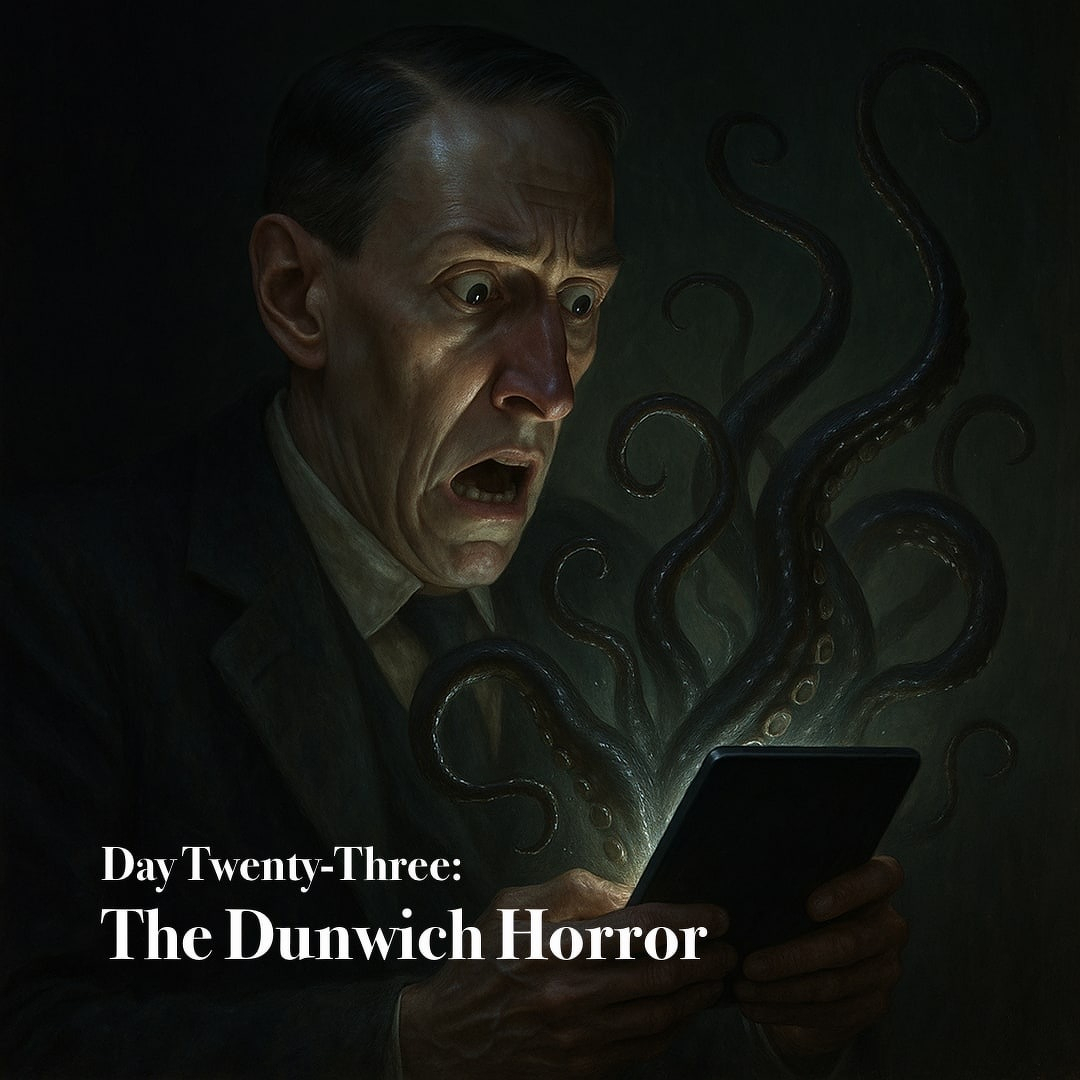
“The Dunwich Horror,” among the most oft-whispered of H. P. Lovecraft’s abominable creations, stirred within me but a faint tremor of unease, as though its eldritch pulse had dimmed across the ages. Yet I read on with morbid delight, imagining how such a tale—of unseen spawn and profane rites—might unfold anew as an accursed adventure in the Call of Cthulhu role-playing game, whose genesis, I am certain, was sired by this very tale.
In the moldering hills of Dunwich, where decay clings to every roofbeam and the air reeks of ancient rot, there came into the world one Wilbur Whateley, the loathsome issue of Lavinia Whateley, an albino half-wit, and some father whose identity mortal tongues dare not name. His growth was an affront to nature, for within ten years he stood as a man, though no human mother could have claimed him. The folk of Dunwich avoided his gaze, and the beasts of field and forest shrank from his scent, which was not the odor of any creature born beneath the sun.
Under the tutelage of his grandsire, the wizened sorcerer called Old Whateley, the boy delved into forbidden arts and the blackest rites of witchcraft. Together they tended an unseen horror within their farmhouse, a presence bound to the dread god Yog-Sothoth. The structure grew strange and swollen with secret additions, while neighbors whispered of missing cattle and nocturnal chanting among the hills. When Old Whateley went to his grave and Lavinia vanished into the shadows, the unseen thing swelled to fill the dwelling entire.
Driven by purpose foul and cosmic, Wilbur sought at Miskatonic University the accursed Necronomicon, that he might open a gate to the Old Ones. Thwarted by Dr. Henry Armitage, he crept by night into the library and met death at the jaws of a hound that knew him for what he was. His carcass melted away, leaving only the stench of alien corruption.
Soon after, the imprisoned horror broke free. Invisible and vast beyond comprehension, it trampled the land, slaughtering without mercy. Armitage and his learned companions came with arcane powders and sacred words, revealing for a dreadful instant a form no sane mind could endure. Its dying cries to Yog-Sothoth echoed through the hills as it perished, leaving only a scorched pit. Then the awful revelation came: the monster was Wilbur’s twin, yet more faithful in form to its cosmic sire, a spawn of blasphemy and the cold abysses beyond the stars.
Lovecraft himself deemed “The Dunwich Horror” a tale so infernal that the Weird Tales editor editor Farnsworth Wright might recoil in terror from its printing. Yet the pages of Weird Tales received it, and the author was granted the princely sum of two hundred and forty dollars, the greatest reward his dread imagination had ever drawn from the world of men. Critics have spoken of the tale’s memorable corruption and its creeping sense of doom that grows as a miasma over ancient hills. Some, such as S. T. Joshi, have named it flawed in its struggle between light and darkness, though even he concedes its atmosphere is thick with the essence of nightmare. Within this tale, the Outer God Yog-Sothoth first revealed its presence to mankind, while the Necronomicon uttered its longest blasphemous passage. It was here also that Lovecraft’s haunted geographies took form, for the accursed towns of Arkham and Dunwich, and the unhallowed halls of Miskatonic University, became fixed forever in the cartography of cosmic dread.
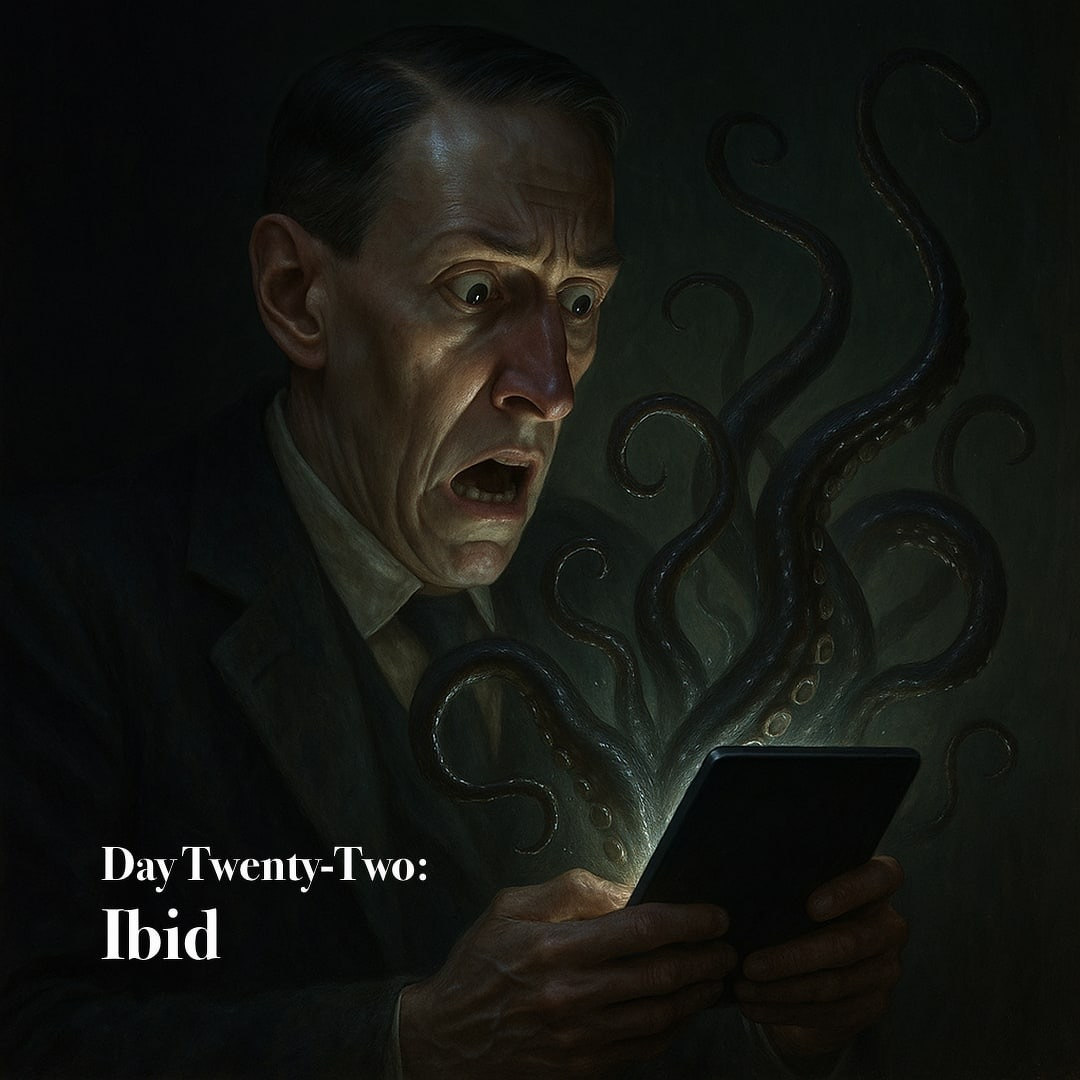
Once more, in this haunted season of October, I have resumed my ancient rite of reading one tale each night from the dread hand of H. P. Lovecraft. In this ritual I have stumbled upon forgotten works, strange and faint in their power, yet still whispering of outer gulfs and nameless terrors. Even the curious jest of “Ibid” carries a shadow of that unearthly genius which once dreamt beyond the veil.
“Ibid” is that grotesque and mirthful chronicle concerning Ibidus of Rome (486–587), a scholar whose dread opus, Op. Cit., sought to distill all the hidden tides of Graeco-Roman thought into one blasphemous perfection. Yet even death could not bind his influence. His skull—an object accursed, passed from the coronets of Charlemagne and William the Conqueror through shadowed centuries—moved at last across the seas to the fevered shores of the New World. Through the witch-haunted lanes of Salem and the dream-corrupted streets of Providence it journeyed, guided by unseen wills, until the relic found its obscene repose within a prairie dog hole beneath the forsaken earth of Milwaukee. Thus the laughter of eternity echoes faintly through decay. First published in that unhallowed journal O-Wash-Ta-Nong, January, 1938.

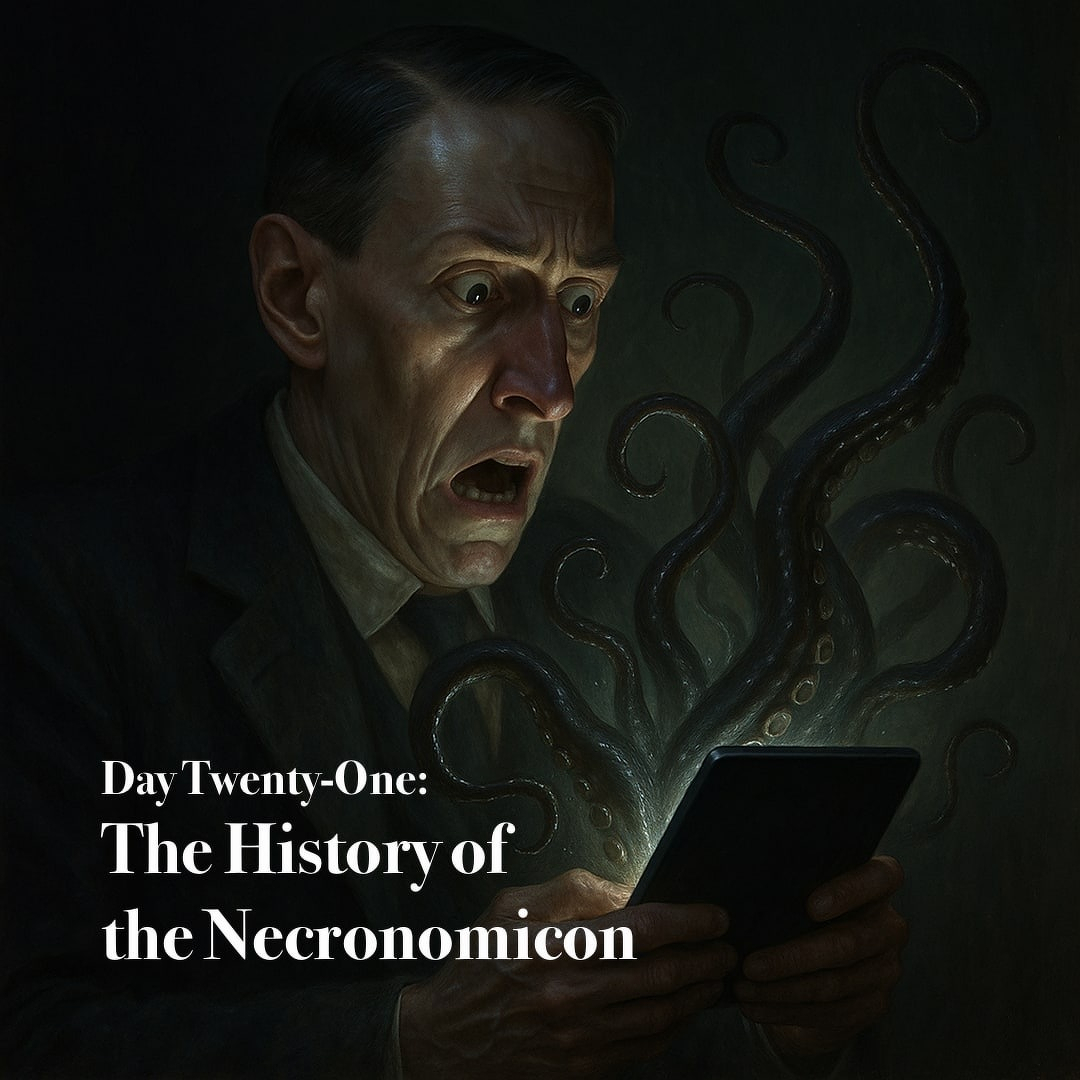
As I perused that most infamous of tales, H. P. Lovecraft’s dread account of “The History of the Necronomicon”, a hideous recognition seized my mind. For in its pages I discerned the very structure of that modern equivalent men call Wikipedia. Both stand as living grimoires, written and rewritten by unseen hands across the gulfs of time. Their countless links are runes of summoning; their citations, dire incantations binding thought to thought in a web too intricate for sanity. Each page opens into another abyss, a digital labyrinth where knowledge writhes and reason sickens beneath the weight of its own impossible infinity. Only one mark was lacking to complete the horror, those blasphemous words that whisper of uncertainty itself: Citation needed.
Let us review today’s tale, shall we?
The dread tome men name the Necronomicon was wrought in elder days by the mad Arab Abdul Alhazred, who set down his unhallowed visions beneath the title Al-Azif. Soon thereafter he perished hideously, torn asunder by invisible demons before a shrieking crowd. Though the primal Arabic script and its Greek translation have long been lost, five Latin renderings endure in hidden vaults—the British Museum, the Bibliothèque nationale, Buenos Aires, Harvard’s Widener Library, and the accursed archives of Miskatonic University—while certain furtive collectors whisper of rarer copies.
The figure of Alhazred sprang from Lovecraft’s youth, a phantasmal pseudonym born of One Thousand and One Nights, perhaps punning “all-has-read” or recalling Providence’s Hazard line. Yet the name itself jars against true Arabic, and later forms sought to render it “Abdullah Alhazred.” In 1927, Lovecraft cloaked this invention with his History of the Necronomicon, weaving real pontiffs and patriarchs with spectral scholars, a false chronicle that lent verisimilitude to his mythos. This artifice, pseudobiblia, became a weapon of dread realism, eagerly adopted by fellow dreamers such as Clark Ashton Smith.
But the snare of illusion caught more than readers: occultists mistook the jest for revelation, and counterfeit Necronomicons were soon pressed upon a credulous world. Critics discern in this device both Lovecraft’s orientalism and his loathing of the unfamiliar, for in casting the East as a land of mystery and terror, he mirrored his own prejudices. Others perceive a darker irony—that in conjuring the “Mad Arab,” he mocked the very academies that suppress and then commodify alien lore. Scholars now behold in his pages a divided mind, wherein fear of the foreign walked hand in hand with awe before its ancient splendor, and thus the shadowed figure of Abdul Alhazred stands at once as caricature and as veneration, a paradox born of the master’s own conflicted soul.

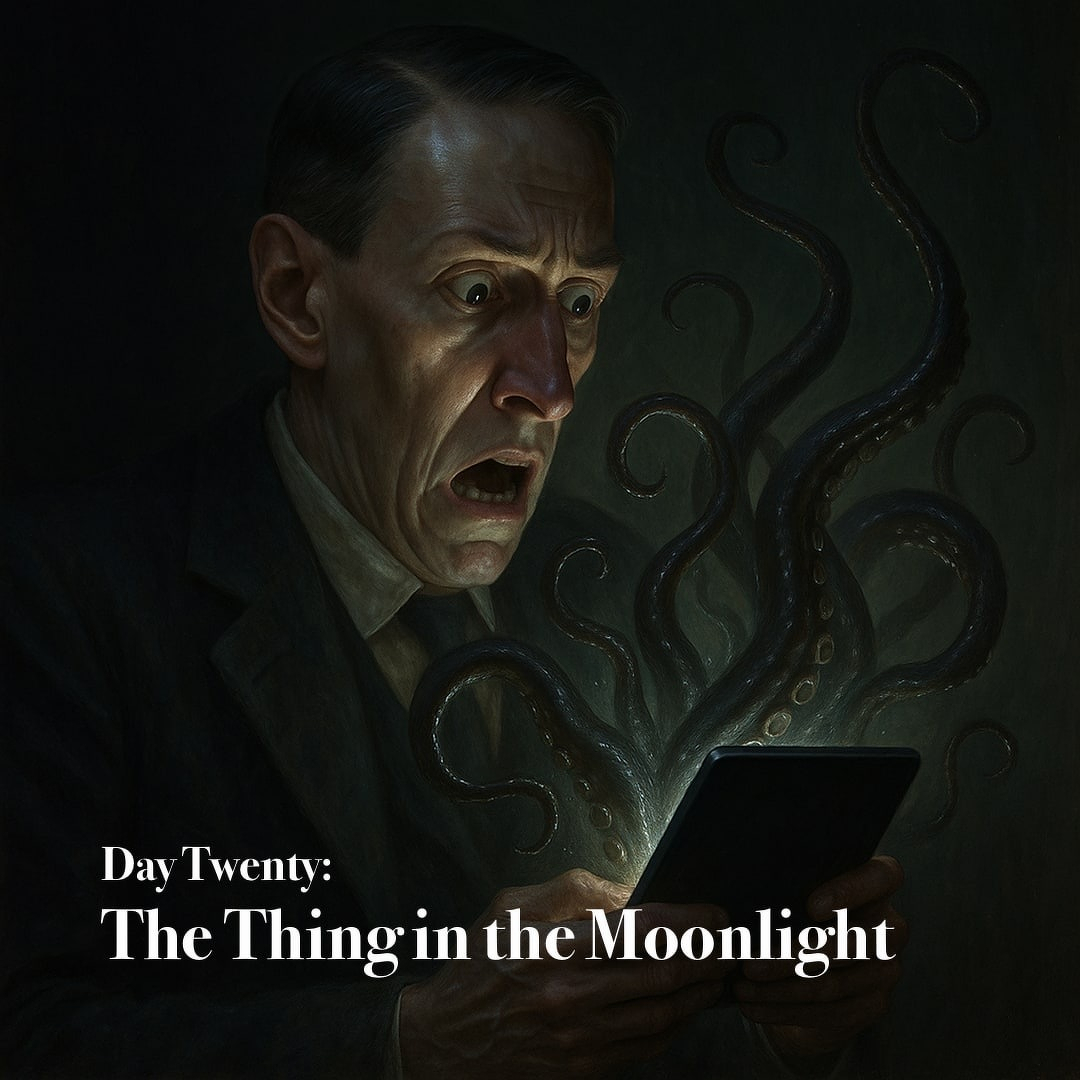
Today marks the eighth turning of my grandson’s mortal years, a span which, to my faltering perception, has fled as swiftly and as strangely as a dream at dawn. How brief the procession of time seems, for it was but yesterday, or so my disordered senses insist, that I stood beside his crib in that sterile chamber of the hospital, gazing in wonder at the small, unknown creature whose soul had only just crossed the threshold of this tenuous world. Even then, I fancied some inscrutable destiny lay before him, as though the cosmos itself paused to regard what manner of being had entered its fold.
This day we shall commemorate his arrival upon Earth by venturing to that vast menagerie men call the San Diego Safari Park, place wherein creatures of all climes and epochs dwell together in strange mockery of the wild order Nature first ordained. The boy speaks with bright fervor of the cheetah, that lithe feline of motion whose speed defies the eye and stirs ancestral memories of pursuit and peril. I cannot but admire his innocent anticipation, though in the darker chambers of thought I sense how fleeting are the joys of youth before the encroaching immensities of time.
Before we set forth, I chanced to read one of H. P. Lovecraft’s lesser-known works, “The Thing in the Moonlight”, a brief yet dreadful whisper from those shadowed gulfs that yawn beyond the veil of sleep. Its spectral visions linger in my mind, twining with the day’s more wholesome expectations, until I scarcely know where reverence ends and dread begins. Thus do love and terror commingle, as they ever have, in the frail heart of man.
Morgan, our protagonist, though unlettered and ignorant of the written art, was seized by an impulse beyond mortal reckoning, and with trembling hand inscribed words not his own. What issued forth was the dream-chronicle of one Howard Phillips, who averred that since the dread night of November 24, 1927, he had slumbered without awakening. In his endless dream he roamed a noisome marsh, its cliffs riddled with cavernous mouths that seemed to gape with silent hunger. Ever did he return to the spectral railway car of yellow hue, numbered as of an age long dead. Within lurked shapes too vile for sanity, one slinking to all fours like a beast, the other bearing a visage no human skull could frame: a pallid cone tapering hideously to a scarlet, questing tentacle. Though Phillips knew the phantasm to be but a dream, no dawn could rouse him, and he fled night upon night before that eldritch horror. Morgan himself trembled at what such testimony implied, and dared not set foot near Phillips’ Providence abode, lest truth outstrip dream.
“The Thing in the Moonlight” (1941), wrought by J. Chapman Miske from a letter Lovecraft penned to Donald Wandrei in 1927, enshrines this nightmare in fuller tale. Miske, in places, echoed so well the cadence of Lovecraft that the voice of the dreamer seemed to throb again from beyond, its first printing appearing in the haunted pages of Bizarre magazine.

Having lately perused that singular novella, The Dream-Quest of Unknown Kadath, and the novel, The Case of Charles Dexter Ward, I fancied that a descent into one of H. P. Lovecraft’s shorter compositions might offer respite from the vast gulfs of cosmic dread his longer works disclose. Yet such solace was illusory. For in turning to that obscure relic entitled “The Very Old Folk”, I found myself ensnared once more in the black immensities of antiquity, those haunted epochs when elder powers stalked beneath alien stars. The vision of a Roman legion, proud and doomed, groping through the abominable wilds of ancient Hispania, only to brush against forces predating mankind itself, seized my soul with both wonder and despair. Alas, the tale was brief, a mere glimpse into that abyss where forgotten gods and primal cults slumber. Would that others, more daring or deranged, might venture further along the path Lovecraft traced, and illuminate what nameless horrors lurk beyond the dim frontier of his imagination.
It was, as our narrator himself confesses, no ordinary tale but a record of a dream, though what mortal sleep could conjure such hideous verisimilitude I dare not ponder. The dreamer beheld himself as a Roman official stationed in the Vascon country, near ancient Pompelo, where each passing year brought with it dread visitations from the accursed hill people. These degenerates, relics of elder stock, would descend by night to seize the innocent, bearing them away to cruel altars and obscene sabbaths beyond the reach of law or light.
A riot, born of long festering loathing, had lately sundered the fragile peace between townsfolk and mountaineers. Strange rumors whispered of vanished traders and eerie silences in the uplands. Stirred by both civic duty and nameless foreboding, the dreamer resolved to lead an armed host into those haunted hills, guided by one who had drawn his first breath beneath their shadow — a Roman by birth, yet native to that blighted soil.
What followed defies the limitations of mortal reason. As the cohort neared the unhallowed seat of the Sabbath, there came a trembling of earth and an unseen tumult in the air. Horses screamed in mindless terror. The guide — that ill-fated son of the land — fell upon his own sword, shrieking of things whispered since the founding of Pompelo. Torches guttered and went out, though no wind stirred, and the night was pierced by cries that were not wholly human. Then, from the darkness above, came a coldness deeper than winter and a thrumming vastness, like the beating of monstrous wings unseen since the elder aeons.
So ended the dream, in horror and dissolution, and the dreamer, waking with a cry, could only murmur that it had been the most vivid vision in years, drawn from subterranean gulfs of memory best left unprobed, where the oldest fears of man yet stir and mutter beneath the thin crust of the conscious mind.
“The Very Old Folk” is the title bestowed by later publishers upon a vision set down by H. P. Lovecraft in a letter of the third of November, 1927, to his confidant Donald Wandrei. Born of the fevered gulfs of dream, it was thereafter read by Frank Belknap Long, who, struck with its unearthly resonance, besought Lovecraft’s leave to weave its spectral substance into his own dark fiction. This leave was granted, and so the phantasmal fragment found new life amid the dread pages of The Horror from the Hills, where its echo of immemorial antiquity lingers still, whispering of races older than man and Sabbaths not meant for mortal remembrance.
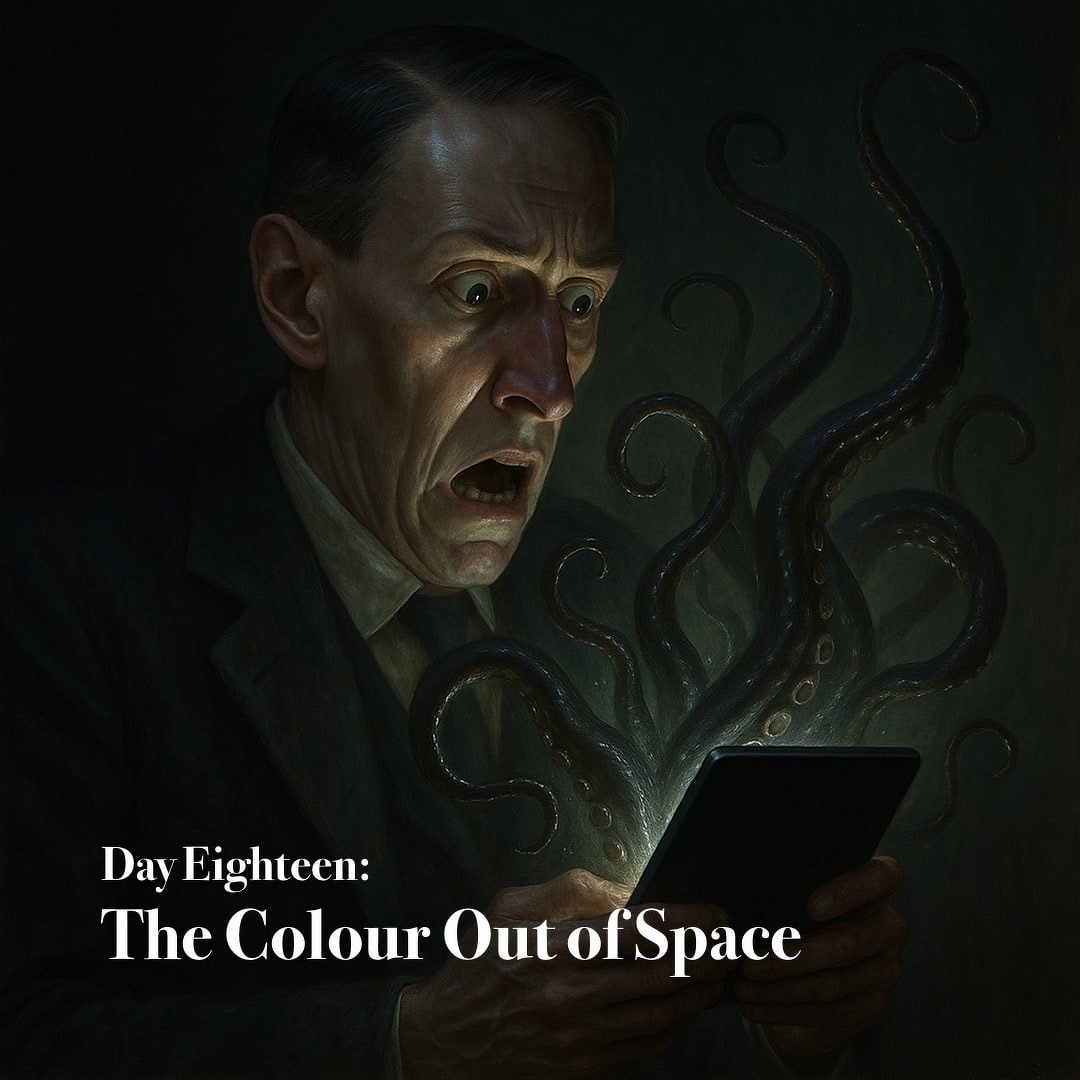
Ever have I approached with trepidation those cinematic ventures which dare to translate the dread imaginings of H. P. Lovecraft into the vulgar medium of the screen. Too oft hath the unnamable been given form, and the ineffable, a mask of papier-mâché, until what should have inspired awe and trembling is rendered grotesque parody. For this reason do I favor works merely inspired by Lovecraft, rather than those which presume to adapt him outright.
Yet last month I steeled myself, and beheld Color Out of Space (2019), directed by Richard Stanley and with Nicolas Cage as its star. Long had I resisted, for I feared disappointment. In this telling, the Gardner farmstead is stricken by a meteor of radiant hue, whose alien essence poisons the soil, the well, and the very lives of those who dwell there. Strange botanies sprout, livestock twist into abominations, and human flesh is fused in ghastly amalgam. Madness reigns: Theresa and young Jack become a single monstrosity, Benny is lost, and Lavinia is claimed by forces from beyond. Nathan, maddened patriarch, ends his kin with grim mercy before his own fall. Only Ward, the hydrologist, endures to bear witness to the ashen blasted heath that remains, where once life flourished, and where now only silence and horror reign beneath a new-laid reservoir.
As a work of horror cinema, it suffices. Indeed, it surpasses many a clumsy attempt before it. As an adaptation of Lovecraft’s tale, it achieves more than most, though it yet falls short of that ungraspable something which no art may wholly render. Still, I give reverence to those who dared the attempt, and offer a word of praise: bravo!
Let us proceed to today’s tale, “The Colour Out of Space”.
In the hills beyond sombre Arkham lies a place the rustic folk shun. Ae blasted heath, where no wholesome thing will grow and where the very air reeks of an ancient blight. Into this desolation a Boston surveyor came, and there he sought out aged Ammi Pierce, the lone witness to the doom of the Gardner farm. From Pierce’s trembling lips came the tale: in the summer of 1882 a star-born stone fell upon Nahum Gardner’s land, within it a globule of no hue known to earth: an alien radiance beyond the mortal prism. Scholars examined it in vain, until lightning shattered the thing and it passed from sight, yet not from influence.
Thereafter the fields bore monstrous harvests, swollen yet unfit for consumption, and the cattle twisted into abhorrent forms before perishing. The Gardners themselves waned in flesh and spirit: the wife and son Thaddeus raving in the attic, the brothers Merwin and Zenas lost forever to the tainted well, and Nahum himself withering into madness, whispering that the Colour drank the very essence of life. Ammi, venturing into that accursed house, found the wife a grotesque mockery of being and released her mercifully. Soon after, Nahum too succumbed. When men of Arkham came with Ammi, they found bones at the well’s bottom and then beheld the unearthly Colour surge forth—rising into the firmament, yet leaving behind a fragment that sank into the soil, a remnant to poison the land for all time.
Thus was written “The Colour Out of Space” in March of 1927, wrought in the same season as The Case of Charles Dexter Ward and Lovecraft’s grand essay on the macabre. Though he spoke of Rhode Island’s Scituate Reservoir as seed, sages discerned other inspirations—the Quabbin works in Massachusetts, Charles Fort’s thunderstones, the tragedy of the Radium Girls, and even Goddard’s rockets clawing at the heavens. Lovecraft sought here to limn a terror wholly alien, a being beyond man’s feeble categories of life and death, its very essence unnameable save as Colour.
First appearing in Amazing Stories that September, it earned Lovecraft scant coin and tardy payment from “Hugo the Rat.” Yet critics hailed it, Edward O’Brien placing it upon the roll of honor, and in after years it was lauded as among his most perfect unions of science and dread. Scholars S. T. Joshi and Donald R. Burleson praised its nameless horror, while E. F. Bleiler deemed it the finest jewel of Amazing Stories. Now in the public domain, its baleful influence lingers, echoed in Brian Aldiss’s The Saliva Tree and Michael Shea’s sequel The Color Out of Time. Still the tale endures, a testament to an author’s attempt to evoke the truly inhuman, and to the fear that somewhere beneath the soil a fragment yet hungers.

In youth, I lamented that H. P. Lovecraft, the dread-master of Providence, had penned so few volumes of length. Yet now, seasoned by years and insight, I discern the wisdom of his brevity. In his tales of compact design lies the truest distillation of cosmic terror, each word a tincture of nightmare. The Case of Charles Dexter Ward held savory moments of ancestral horror, and I thrilled at the invocation of Pickman and Wheaton; yet its longer form languished like a dream stretched thin, its vitality dispersed among too many mortal pages. Had I dared peruse it beneath the waning lamp, I fancy sleep—or something colder—might have claimed me ere its final revelation.
In Providence whose crooked lanes and mouldering steeples brood darkly over Narragansett Bay, there dwelt one Charles Dexter Ward, scion of a venerable family and victim to a fate more baleful than madness. From the wards of a madhouse he vanished, his cell strangely thick with dust, leaving only whispers of a dreadful transformation. It fell to Dr. Marinus Willett, physician and reluctant seeker into forbidden matters, to unravel the hideous skein.
Through musty tomes and clandestine inquiries Willett traced Ward’s decline to an obsession with his forebear, Joseph Curwen, a merchant of the eighteenth century whose name was whispered only in fear. For Curwen trafficked in necromancies unholy, and a midnight raid upon his farm had once revealed shrieks, lights, and shapes not wholly human, sworn thereafter to secrecy. Ward, probing into Curwen’s ashes and hidden scripts, dared the unhallowed rite of resurrection, calling forth the sorcerer from his “essential saltes.” Disguised in his descendant’s guise, Curwen walked again among men until his anachronisms betrayed him to the asylum.
Willett, pursuing the trail to a Pawtuxet bungalow that cloaked the accursed catacombs of Curwen’s first dominion, beheld ghastly vaults, experiments beyond sanity, and a conspiracy of necromancers spanning centuries, who tortured the mighty dead for knowledge that might shatter mankind’s destiny. In that obscene laboratory the doctor unwittingly summoned a primordial adversary of Curwen. Swooning, he awoke to sealed passageways and a Latin charge: to reduce the usurper to dust.
With trembling resolve Willett confronted Curwen in his asylum cell, invoking the counter-formula that undid the blasphemous rebirth. The necromancer crumbled into motes of ash, and soon thereafter his fellow conspirators perished in calamities befitting their guilt.
Lovecraft himself deemed the chronicle “cumbrous, creaking bit of self-conscious antiquarianism,” leaving it unpublished until August Derleth and Donald Wandrei exhumed it after his death. Within its pages first glimmers Yog-Sothoth, whispers of the Necronomicon, and symbols known to Randolph Carter. Later writer, like Brian Lumley, would seize its formulae to conjure flesh from ash, while the incantations, drawn from Eliphas Levi, rang with the names of gods and elemental spirits. Thus endures the legacy of Ward and Curwen, a warning etched in dust and dread.
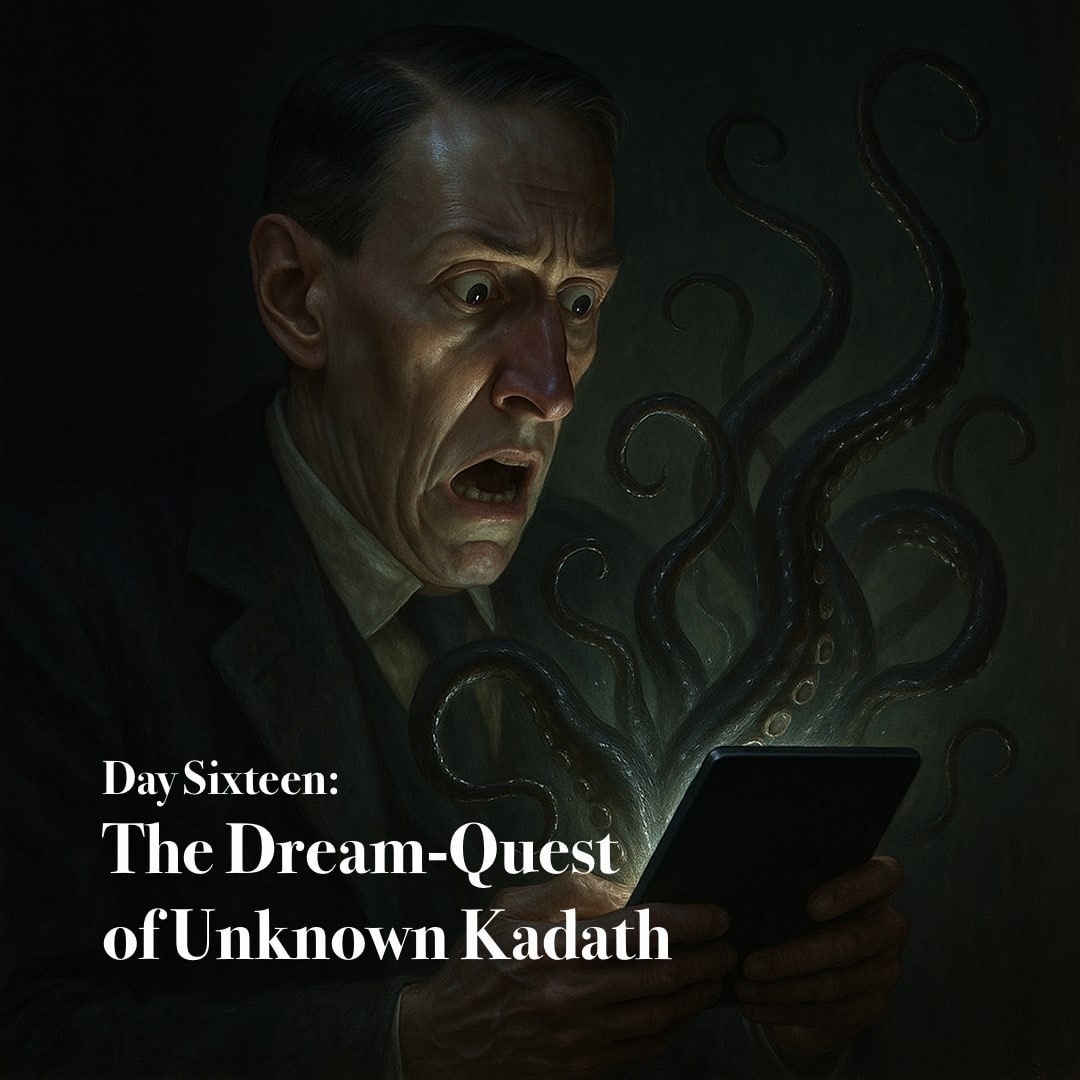
Yesterday, as I perused “The Strange High House in the Mist” from that blasphemously vast tome, The Complete Works of H. P. Lovecraft, I pondered with dread how I might reach its end ere the waning of the month. By my reckoning, the final tale would fall upon the eve of All Hallows, yet the accursed volume mocked me, revealing but a third of its depths explored.
Today, in venturing through H. P. Lovecraft’s “The Dream-Quest of Unknown Kadath”, the riddle found its answer. For that tale is no mere story but a delirious odyssey, a fevered scripture of dream and revelation. Four mortal hours slipped by like whispers from the abyss, and when at last I closed the book, I was unsure whether I had read it, or dreamt it. The memories that lingered were but phantasmal fragments: shimmering towers, impossible skies, and gods that moved like shadows beyond the waking mind, as if illustrated by the likes of Winsor McCay and P. Craig Russel. It seemed as though the tale had read me, drawing my soul across the veiled gulf between sleep and madness.
In the half-lit gulfs where sleep and waking intermingle, Randolph Carter beheld oft a city of opalescent glory—its towers radiant, its streets suffused with the beauty of forgotten suns. Yet when that dream-vision fled from his nightly wanderings, Carter, undaunted, swore to ascend unto dread Kadath, where the gods of dream brood in their cold and perilous silence. Priests in border temples muttered of doom, whispering that the gods themselves had veiled the city from his sight. Still Carter pressed on, threading the perilous lore of Zoogs, heeding the counsel of Atal in fur-haunted Ulthar, and seeking the visage of gods carved colossal on mountain slopes.
His wanderings grew dire. Seized by turbaned slavers, he was borne to the moon and thrust before the obscene moon-beasts, servants of Nyarlathotep. Yet the cats of Ulthar, his steadfast allies, swept down in yowling hosts to bear him free. Nightgaunts, faceless and winged, dragged him into the abyssal underworld, but ghouls led by his comrade Richard Pickman, now forever changed, guided him through the loathsome city of the Gugs. Thence he strode to Celephaïs, where King Kuranes, who had forsaken life for dream, sought vainly to dissuade him. Onward he pressed to Inganok, to Leng, and to the accursed monastery whose priest none dare name, where Carter glimpsed a truth that froze his soul.
From moon-beast citadels to nightgaunt wings, he battled, bargained, and climbed until at last he stood in Kadath itself. Yet the halls were empty, abandoned by the gods who had fled to dwell in Carter’s own lost childhood Boston. There, in regal mockery, Nyarlathotep revealed the truth and sent Carter spiraling not to his sunset city but unto the blind idiot Azathoth at chaos’ center. Only the sudden remembrance of dream’s dominion wrenched him awake, sparing his soul. Nyarlathotep, balked, seethed amidst Kadath’s black spires, while the mild gods crept back to their stolen city.
“The Dream-Quest of Unknown Kadath,” wrought of strange borrowings, from William Thomas Beckford’s Vathek, from Edgar Rice Burroughs’ Barsoom, from L. Frank Baum’s Oz, and from Lord Dunsany’s jeweled phantasies, stands both reviled and revered. Some find it unreadable, others hail it as akin to Lewis Carroll or George MacDonald. Lovecraft himself dismissed it as “poor practice,” yet even Dunsany, shown its pages, confessed with ironic grace: “I see Lovecraft borrowed my style.”
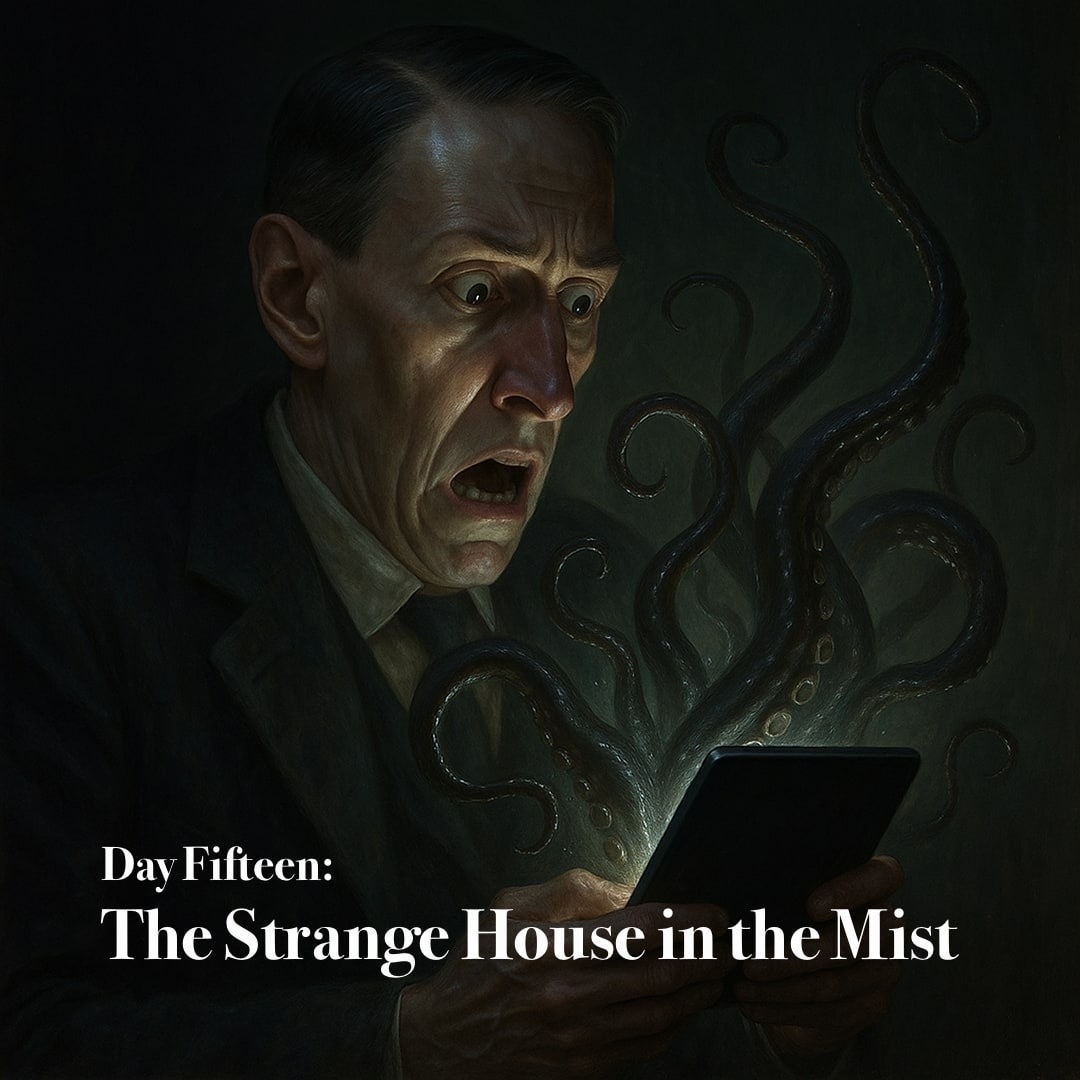
In those dim and formative years of my literary wanderings, I first beheld the dread artistry of H. P. Lovecraft through a volume most curious—The Best of H. P. Lovecraft: Bloodcurdling Tales of Horror and the Macabre, its cover adorned by the ineffable hand of Michael Whelan, and issued by the house of Del Rey and Ballantine. Within those pages, the shadows stirred and whispered, and from their eldritch call I could not turn away. Soon after, as if compelled by some unseen cosmic hand, I acquired further grim tomes—The Tomb and Other Tales, The Dream-Quest of Unknown Kadath, and The Case of Charles Dexter Ward—each a gateway to realms of impossible antiquity and madness.
For many years, those books were the whole of my acquaintance with Lovecraft’s dark scripture. Yet in the waning light of the last year, curiosity drove me again to the abyss: I downloaded The Complete Works of H. P. Lovecraft to my Kindle, and there, amid that vast electronic tome, I found tales both familiar and strange. One in particular, “The Strange House in the Mist,” had eluded my earlier readings. Many speak of it with reverence, yet to me it seemed an echo without power, a relic of dream rather than of nightmare. Still, I would not deny others their enchantment; for who can say which tales the unseen gods of our subconscious will claim as their own, or which cup of tentacled tea may taste sweet upon another’s tongue?
In the eldritch town of Kingsport there looms a house of unspeakable antiquity, perched high upon a crag that gazes out over the boundless sea. Toward this dread and mist-wreathed dwelling came Thomas Olney, a humble philosopher, whose soul was stirred by whispers older than memory. With great peril he scaled the sheer precipice and beheld the enigmatic master of that abode, whose only portal yawned upon vapors and abyss. There, amidst archaic lore and unearthly visitants, Olney partook of mysteries beyond mortal ken. When he returned to Kingsport, he walked as though hollowed, his mortal shell intact yet his spirit lingering forever in that supernal house above the mists.
Lovecraft, inspired by Lord Dunsany’s Chronicles of Rodriguez and the looming headland of Mother Ann in Massachusetts, penned this spectral vision. Though first rejected by Weird Tales in 1927 and later promised to The Recluse, fate delayed its unveiling until 1929, when Weird Tales at last accepted it, granting Lovecraft a meagre fifty-five dollars. In after years, critic Robert A. W. Lowndes hailed “The Strange High House in the Mist” as one of the master’s most haunting and consummate tales.

Finished reading: Writing the Murder edited by Dan Coxon 📚

Finished reading: Jerusalem by Alan Moore 📚 The folks at the Supercontext Podcast turned me on to this tome, which devoured more than a year of my life reading it. Thanks, guys!
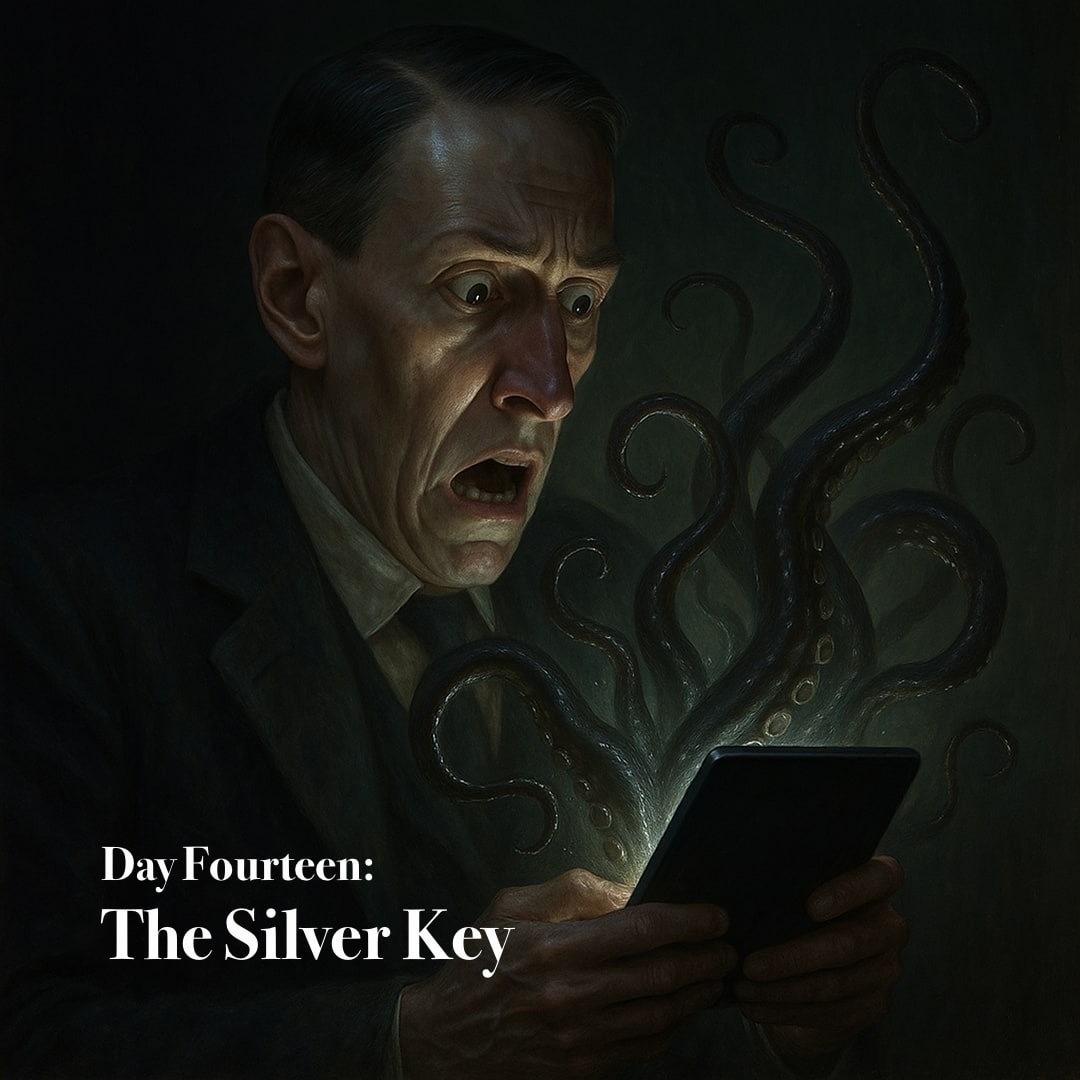
As you might well surmise, the quiet custom of reading one tale each October day from the accursed pen of Howard Phillips Lovecraft provides a curious occasion for reflection upon my long and changing acquaintance with his work. When first I was introduced to his singular literature, I had not yet reached my eighteenth year, and now I find myself well into the somber corridors of middle age. Time has altered not only my countenance but also the quality of my admiration, so that what once thrilled me now leaves me pensive, and what once seemed lesser has grown in secret power.
In revisiting the tales of the recluse of Providence, I have come to favor his stories of the supernatural above those of his vast and dreadful cosmos. The subtle horrors, rooted in the mortal and the spectral, touch my spirit more deeply than those that whisper from beyond the stars. I take especial delight in again meeting the shades of tales I have long cherished, such as “In the Vault” and “Pickman’s Model”., which remain as potent and as grave as when I first encountered them. None have diminished in my esteem, and others, such as “The Silver Key”, now reveal depths I once overlooked.
In the impatience of youth, I would hurry through “The Silver Key”, eager to reach what I believed were the greater marvels of Lovecraft’s mythic imaginings. Yet now, with the weariness and reflection that come to men of my years, I find myself drawn to its quiet melancholy and to its dreamer, Randolph Carter. He too lamented the passing of mystery from the world, and I, like him, perceive that we dwell in an age stripped of its wonder. The iron spirit of pragmatism has banished enchantment from our waking lives, leaving us poorer, though we are too proud to confess it.
Not always do I feel this melancholy, yet there are moments when I look upon the world and sense that it has grown barren of the unseen. In such hours, I cannot help but wish that I, too, possessed Carter’s key, that fragile token which opens the hidden door between dream and remembrance, and leads once more to the lost kingdoms of the soul.
At the age of thirty, Randolph Carter beheld with despair that he had lost the key to that mystic portal which opens upon the gate of dreams. No longer could he summon the ineffable splendors of enchanted cities and unearthly beings, for the grey weight of waking science and the barren creed of the commonplace had dulled his once-radiant vision. In vain he sought meaning among the schools of philosophy, but their sterile systems brought him naught save emptiness, until at last he fled into solitude.
Then, in the dim recesses of sleep, his long-dead grandsire whispered of a hidden relic—an ancient silver key wrought with cryptic arabesques—resting in the attic’s dust. Carter seized it and returned to the cavern of his boyhood, where, upon uttering the syllables of his blood, he slipped from mortal time and was reborn as a child of ten. Strange it was that kinfolk recalled how, from that tender age, he spoke with uncanny foresight of futures yet unshaped.
The chronicle closes with a haunting promise: that Carter now reigns in a dream-city beyond mortal sight, sovereign of realms where the silver key unlocks the ultimate mysteries of the cosmos.
Thus “The Silver Key” joins his other chronicles: “The Dream-Quest of Unknown Kadath,” “The Statement of Randolph Carter,” “The Unnamable,” and at last “Through the Gates of the Silver Key.” Its tale of spiritual groping recalls J.K. Huysmans’ À rebours. Scorned by Weird Tales in 1927, then grudgingly printed a year hence, it was greeted by readers with “violent distaste,” though its eldritch music endures for those attuned to the hidden harmonies of dream.
Watched: Eddington 🍿